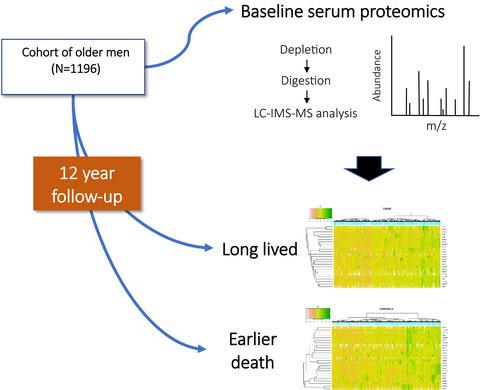当前位置:
X-MOL 学术
›
Aging Cell
›
论文详情
Our official English website, www.x-mol.net, welcomes your feedback! (Note: you will need to create a separate account there.)
Proteomic assessment of serum biomarkers of longevity in older men
Aging Cell ( IF 7.8 ) Pub Date : 2020-10-20 , DOI: 10.1111/acel.13253 Eric S Orwoll 1 , Jack Wiedrick 1 , Carrie M Nielson 1 , Jon Jacobs 2 , Erin S Baker 3 , Paul Piehowski 2 , Vladislav Petyuk 2 , Yuqian Gao 2 , Tujin Shi 2 , Richard D Smith 2 , Douglas C Bauer 4 , Steven R Cummings 5 , Jodi Lapidus 1 ,
Aging Cell ( IF 7.8 ) Pub Date : 2020-10-20 , DOI: 10.1111/acel.13253 Eric S Orwoll 1 , Jack Wiedrick 1 , Carrie M Nielson 1 , Jon Jacobs 2 , Erin S Baker 3 , Paul Piehowski 2 , Vladislav Petyuk 2 , Yuqian Gao 2 , Tujin Shi 2 , Richard D Smith 2 , Douglas C Bauer 4 , Steven R Cummings 5 , Jodi Lapidus 1 ,
Affiliation

|
The biological bases of longevity are not well understood, and there are limited biomarkers for the prediction of long life. We used a high‐throughput, discovery‐based proteomics approach to identify serum peptides and proteins that were associated with the attainment of longevity in a longitudinal study of community‐dwelling men age ≥65 years. Baseline serum in 1196 men were analyzed using liquid chromatography–ion mobility–mass spectrometry, and lifespan was determined during ~12 years of follow‐up. Men who achieved longevity (≥90% expected survival) were compared to those who died earlier. Rigorous statistical methods that controlled for false positivity were utilized to identify 25 proteins that were associated with longevity. All these proteins were in lower abundance in long‐lived men and included a variety involved in inflammation or complement activation. Lower levels of longevity‐associated proteins were also associated with better health status, but as time to death shortened, levels of these proteins increased. Pathway analyses implicated a number of compounds as important upstream regulators of the proteins and implicated shared networks that underlie the observed associations with longevity. Overall, these results suggest that complex pathways, prominently including inflammation, are linked to the likelihood of attaining longevity. This work may serve to identify novel biomarkers for longevity and to understand the biology underlying lifespan.
中文翻译:

老年男性长寿血清生物标志物的蛋白质组学评估
长寿的生物学基础还不是很清楚,预测长寿的生物标志物也很有限。我们使用高通量、基于发现的蛋白质组学方法来鉴定与年龄≥65 岁的社区男性的纵向研究中获得长寿相关的血清肽和蛋白质。使用液相色谱-离子淌度-质谱分析了 1196 名男性的基线血清,并在约 12 年的随访期间确定了寿命。实现长寿(≥90% 预期生存率)的男性与较早死亡的男性进行了比较。控制假阳性的严格统计方法被用来识别 25 种与长寿相关的蛋白质。所有这些蛋白质在长寿男性中的丰度较低,并且包括与炎症或补体激活有关的多种蛋白质。较低水平的长寿相关蛋白也与更好的健康状况有关,但随着死亡时间的缩短,这些蛋白质的水平会增加。通路分析表明,许多化合物是蛋白质的重要上游调节剂,并涉及构成观察到的长寿关联的共享网络。总体而言,这些结果表明,复杂的途径,主要包括炎症,与获得长寿的可能性有关。这项工作可能有助于识别长寿的新生物标志物并了解寿命的生物学基础。但随着死亡时间的缩短,这些蛋白质的水平会增加。通路分析表明,许多化合物是蛋白质的重要上游调节剂,并涉及构成观察到的长寿关联的共享网络。总体而言,这些结果表明,复杂的途径,主要包括炎症,与获得长寿的可能性有关。这项工作可能有助于识别长寿的新生物标志物并了解寿命的生物学基础。但随着死亡时间的缩短,这些蛋白质的水平会增加。通路分析表明,许多化合物是蛋白质的重要上游调节剂,并涉及构成观察到的长寿关联的共享网络。总体而言,这些结果表明,复杂的途径,主要包括炎症,与获得长寿的可能性有关。这项工作可能有助于识别长寿的新生物标志物并了解寿命的生物学基础。与获得长寿的可能性有关。这项工作可能有助于识别长寿的新生物标志物并了解寿命的生物学基础。与获得长寿的可能性有关。这项工作可能有助于识别长寿的新生物标志物并了解寿命的生物学基础。
更新日期:2020-11-23
中文翻译:

老年男性长寿血清生物标志物的蛋白质组学评估
长寿的生物学基础还不是很清楚,预测长寿的生物标志物也很有限。我们使用高通量、基于发现的蛋白质组学方法来鉴定与年龄≥65 岁的社区男性的纵向研究中获得长寿相关的血清肽和蛋白质。使用液相色谱-离子淌度-质谱分析了 1196 名男性的基线血清,并在约 12 年的随访期间确定了寿命。实现长寿(≥90% 预期生存率)的男性与较早死亡的男性进行了比较。控制假阳性的严格统计方法被用来识别 25 种与长寿相关的蛋白质。所有这些蛋白质在长寿男性中的丰度较低,并且包括与炎症或补体激活有关的多种蛋白质。较低水平的长寿相关蛋白也与更好的健康状况有关,但随着死亡时间的缩短,这些蛋白质的水平会增加。通路分析表明,许多化合物是蛋白质的重要上游调节剂,并涉及构成观察到的长寿关联的共享网络。总体而言,这些结果表明,复杂的途径,主要包括炎症,与获得长寿的可能性有关。这项工作可能有助于识别长寿的新生物标志物并了解寿命的生物学基础。但随着死亡时间的缩短,这些蛋白质的水平会增加。通路分析表明,许多化合物是蛋白质的重要上游调节剂,并涉及构成观察到的长寿关联的共享网络。总体而言,这些结果表明,复杂的途径,主要包括炎症,与获得长寿的可能性有关。这项工作可能有助于识别长寿的新生物标志物并了解寿命的生物学基础。但随着死亡时间的缩短,这些蛋白质的水平会增加。通路分析表明,许多化合物是蛋白质的重要上游调节剂,并涉及构成观察到的长寿关联的共享网络。总体而言,这些结果表明,复杂的途径,主要包括炎症,与获得长寿的可能性有关。这项工作可能有助于识别长寿的新生物标志物并了解寿命的生物学基础。与获得长寿的可能性有关。这项工作可能有助于识别长寿的新生物标志物并了解寿命的生物学基础。与获得长寿的可能性有关。这项工作可能有助于识别长寿的新生物标志物并了解寿命的生物学基础。



























 京公网安备 11010802027423号
京公网安备 11010802027423号